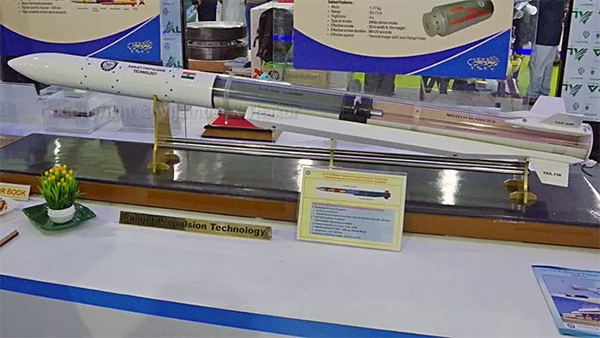DRDO-L&T Light Tank to rollout by 2023
A DRDO & Larsen and Toubro light tank is currently under fabrication, based on the chassis of DRDO’s Next Generation Main Battle Tank (NGMBT) and the rollout of the first prototype is likely to happen in 2023.
This will also strengthen the DRDO’s proposal to develop the Next Generation Main Battle Tank (NGMBT) to meet the Indian Army’s requirement for 1,770 Next Generation Main Battle Tank (NGMBT) under Future Ready Combat Vehicles (FRCV) program.
Talks have already started that the Next Generation Main Battle Tank will be manufactured through a Special Purpose Vehicle (SPV) under a public Private partnership model which has been adopted for the development of the 5.5 generation AMCA and Indian Multi-Role Helicopter (IMRH).
Solid Fuel Ducted Ramjet technology successfully tested
DRDO successfully flight tested Solid Fuel Ducted Ramjet (SFDR) booster at the Integrated Test Range (ITR), Chandipur off the coast of Odisha on 8 April 2022. The test successfully demonstrated the reliable functioning of all critical components involved in the complex missile system and met all the mission objectives.
The SFDR-based propulsion enables the missile to intercept aerial threats at very long range at supersonic speeds. The performance of the system has been confirmed from the data captured by a number of range instruments like Telemetry, Radar and Electro Optical Tracking Systems deployed by ITR. The SFDR has been developed by Defence Research and Development Laboratory, Hyderabad in collaboration with other DRDO laboratories such as Research Centre Imarat, Hyderabad and High Energy Materials Research Laboratory, Pune.
Short Range Naval Anti-Ship Missile (NASM-SR) Ready
DRDO was in the process of developing a Naval Antishipping Missile Short Range (NASM-SR) with an estimated range of 55 km for use from Sea King helicopters and eventually equip the MH-60R helicopters. This project is possibly being developed for a number of platforms, having different ranges. ‘SR’, or Short Range, means that development of other longer range versions is expected as well.
According to DRDO, the NASM-SR will be a 380 kg projectile with a maximum range of 55 km and used initially with Indian Navy Sea King helicopters, replacing the earlier Sea Eagle missiles. As the Sea King itself is approaching the end of its service life, it may be expected that the new indigenous missile will be in service with future helicopters of the Navy.
The American made MH-60R helicopters is due to arrive in July 2022 which is a multi-role platform and these are slated to be equipped with Kongsberg Naval Strike Missile. Further, for the Indian Navy’s IMRH acquisition, MBDA pitched its Sea Venom which has a range of 25 km and also the Marte-ER which can reach more than 100 km.
The NASM-SR could be considered for these potent platforms. The long range version of the NASM may have a range excess of 150 km, enabling engagement of hostile targets from stand-off distances.
The Indian Navy is also in the market for new medium range anti-ship missiles (MRAShM) for 24 current and future warships as detailed by Livefist — three Delhi-class destroyers, four Kora-class missile corvettes and the six new Next Generation Missile Vessels (NGMV) that will enter service in the next decade. The other anti-ship missiles currently in service with the Indian Navy are Boeing Harpoon Block-IIIs on the P-8I Poseidon fleet.
Long Range Pinaka missile system Tested
A new version of the Pinaka rocket system has been successfully flight-tested by the DRDO and the Indian Army at the Pokhran firing ranges, the defence ministry said on 9 April. As many as 24 Pinaka Mk-I Enhanced Rocket Systems were fired for different ranges during the last fortnight and the weapons met the required accuracy and consistency, it said.
The EPRS is the upgraded version of the Pinaka variant that has been in service with the Indian Army for the last decade. The ministry said the rocket system has been upgraded with advanced technologies enhancing the range to meet the emerging requirements.
With these trials, the initial phase of technology absorption of EPRS by the industry has successfully been completed and the industry partners are ready for user trials/series production of the rocket system.
The Pinaka rocket system has been developed by Armament Research and Development Establishment, Pune, supported by High Energy Materials Research Laboratory, another Pune-based laboratory of the DRDO.
After establishing the performance efficacy of the enhanced range version of Pinaka, the technology was transferred to Munitions India Limited MIL and Economic Explosives Limited, Nagpur.
Anti-Tank Guided Missile ‘HELINA’ successfully flight tested
Indigenously developed helicopter launched Anti-Tank Guided Missile ‘HELINA’ was successfully flight tested on April 11, 2022 at high-altitude ranges as part of user validation trials. The flight-test was jointly conducted by the teams of scientists from Defence Research and Development Organisation (DRDO), Indian Army and Indian Air Force (IAF).


The anti-tank missile was tested again next day, this time in the northern high altitude mountain regions after its successful test on Monday in the desert regions of Pokhran.
The flight trials were conducted from an Advanced Light Helicopter (ALH) and the missile was fired successfully engaging simulated tank target. The missile is guided by an Imaging Infra-Red (IIR) Seeker operating in the Lock on Before Launch mode.
It is one of the most advanced anti-tank weapons in the world. In continuation to validation trials conducted at Pokhran in Rajasthan, proof of efficacy at high altitudes paves the way for its integration on the ALH. The trials were witnessed by senior Army commanders and senior scientists of the DRDO.
With the flight test, consistent performance of the complete system, including Imaging Infra-Red Seeker, has been established, which will enable the induction of the ‘Helina’ into the armed forces,” said a press statement from the Ministry of Defence on 12 April.
DRDO has said that the Helina missile system has all weather day and night capability and can defeat battle tanks with conventional armour as well as explosive reactive armour. It has been developed for integration with choppers in both the Army and Air Force.
Indo-Israeli Medium-Range Surface-to-Air Missile Tested Twice
India successfully conducted twin tests of Medium-Range Surface-to-Air Missile (MRSAM) from a defence facility off Odisha coast on 27 March 2022 demonstrating the system’s high killing efficiency against high-speed aerial targets.
The network-centric and most advanced sleek missile has been developed by DRDO and Israel Aerospace Industries (IAI) in collaboration with public and private sector enterprises.
The MRSAM-Army system intercepted unmanned aerial vehicles and destroyed them completely achieving direct hits at both long and short ranges. The missile intercepted the target in medium altitude at long range during the first trial and destroyed another target in low altitude at short range during second trial.
With a strike range of nearly 100 km, the 4.5-meter long supersonic quick reaction missile weighs around 2.7 tonne and can carry a payload of 60 kg. Travelling at a speed of Mach 2, it can achieve high degrees of manoeuvrability at the terminal phase.
Each MRSAM unit comprises one command and control system, multi functional surveillance tracking radar, threat alert radar, mobile launcher, combat management system, mobile power and radar power systems apart from the missile.
The next generation weapon system has been developed with cutting-edge technology to neutralise airborne threats like jets, subsonic and supersonic cruise missiles, anti tank systems and rockets.
One of the variants of MRSAM system has already been handed over to Indian Air Force (IAF). The missile is designed to provide point and area air defence for ground assets against a wide range of threats.
Air-launched BrahMos hits targets 800 km away
India is developing a new air-launched version of the BrahMos supersonic cruise missile which would be able to strike at enemy targets at more than 800 kilometres.
India has enhanced the range of the tactical missile recently, and it can go beyond 500 kilometres with just an upgrade in its software.
The Indian Air Force has equipped around 40 of its Su-30 combat aircraft with the BrahMos cruise missiles, which can cause heavy destruction in enemy camps.
BrahMos was also successfully test-fired in the Andaman and Nicobar, on 23 March.
Earlier in March, the Indian Navy had successfully demonstrated the accuracy of an extended-range land-attack Brahmos supersonic cruise missile from the stealth destroyer INS Chennai.













